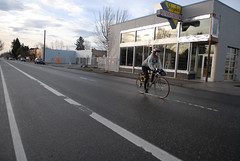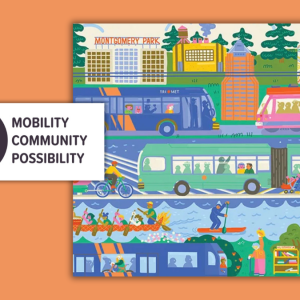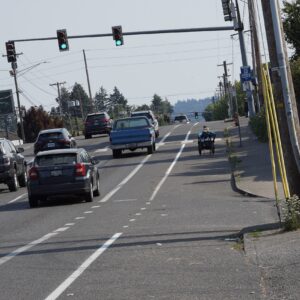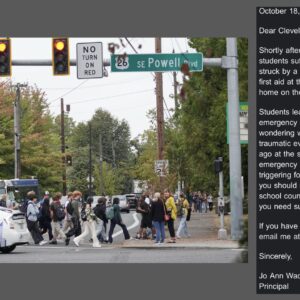
a boring, cheap and narrow bike lane
on Williams Ave in North Portland.
(Photo © J. Maus)
The Railvolution conference kicked off this morning in Portland. About 1,000 transportation professionals, politicians, and other bigwigs are expected to take part in a dizzying array of workshops, networking sessions, and panel discussions. The event is designed to tease out the latest and greatest thinking on the who, what, why and how of transit planning
As the name suggests, Railvolution is all about like streetcars, light rail and commuter rail. But this year, bikes have sneaked onto the agenda with a session titled, Biketopia: Is BOD the New TOD. (For the uninitiated, BOD stands for Bike Oriented Development and TOD stands for Transit Oriented Development). Here’s the summary of the panel:
What role does bicycle-oriented development (BOD) play in TOD? With increasing investment in bike boulevards, cycle tracks and urban trails and paths, there is growing interest in orienting development near fixed bikeway corridors. This workshop takes a look at the surprising benefits of bicycle infrastructure in terms of neighborhood revitalization, urban form and the public realm. With bike culture comes innovation and experimentation: mandatory off-street bicycle storage within new developments, on-street parking spaces replaced by bike corrals, bike-and-ride amenities at transit stations, support for diverse small businesses, unique fashions and creative social events such as Sunday Parkways. Should the definition of TOD be broadened to include bikes? How do the bicycle lessons-learned apply to transit and station area planning?
As someone who has documented one of the great, ongoing examples of BOD in America, I’m excited to be on this panel. I’ll be joined by Alta Planning CEO Mia Birk (moderator), the President and CEO of Bikestation, Andrea White-Kjoss, and local real estate guy Jon Kellogg of Commercial Realty Advisors NW/Adaptive Development.
If you’re registered for the conference, I hope you’ll add this one to your schedule. It’s on Wednesday (10/20) at 10:00 a.m. If you can’t make it, I’ll try and share a recap on Page Two. Learn more at Railvolution.com.






Thanks for reading.
BikePortland has served this community with independent community journalism since 2005. We rely on subscriptions from readers like you to survive. Your financial support is vital in keeping this valuable resource alive and well.
Please subscribe today to strengthen and expand our work.
As Fast Times the movie made famous… ‘TOD has the BOD!’
Yes Portland is putting its own stamp on Railvolution with its this year’s bike focus vs. past years. It makes a lot of sense…given the much higher costs of providing urban transit infrastructure (and car facilities) vs. bikeways and the slow bleed of transit ridership in many markets…and growth of bike commuting.
I await the recap. This should in interesting. Wish I could go
There is one big problem with encouraging development along bike corridors – it will increase the amount of motorized traffic along those corridors.
As much as some of us would like everyone to be “all-bike, all the time”, most people will still own a car for longer trips, inclement weather, and getting across town quickly. (“across town” meaning Gresham to Hillsboro or Troutdale to Milwaukie, not a 5 mile jaunt from 82nd Ave to the downtown REI) Also, with the TOD emphasis on mixed-use, a similar focus along bikeways would introduce commercial traffic (like delivery trucks) into areas which currently are unaffected by those vehicles. If by “focusing development” they mean putting it onto the nearest arterials paralleling the bikeways, then I’m all for it – the “Main Street” concept works great for local businesses, and if multi-family, miulti-use residential is built on Alberta, or Belmont, or Division, with a bikeway 2-4 blocks away, then we’re utilizing and building on the existing infrastructure and density without introducing a lot of expensive changes.
Wish I could be at the conference, but unfortunately I have to work – I look forward to seeing the recap afterwards.
I sure hope that we’ll start to see some realistic boundaries put on street car development. When I hear “20 minute neighborhood” in the context of streetcars (as presented in my neighborhood), I think of the degree to which bikes can create these for substantially less money, with higher health benefits than trains can.
Rail on a nightmare corridors like MLK seems to make sense, but putting it on (now) quieter neighborhood streets always concerns me, because that will displace bikes and promote strips of Pearl District-level development throughout the city.
At the end of the day, it seems like the biggest benefits of these projects accrue to the developers who build projects along them . . . and part of me does not like that math. Where are the big NY-scale bike infrastructure projects? They cost a fraction of the cost per-mile, but perhaps the reason we don’t see them is that developers don’t see any big payoff. Maybe your panel can convince them otherwise.
I hope to live in Portland long enough to see Hawthorne completely car free with only light rail and bike lanes.
Its great to see that Hayduke lives! I am sure he would love to see a beach with a big wide park where the “toxic river” known as Eastbank Freeway now sits, among other things.
He would also be wondering whatever happened to Critical Mass? or is that now just an everyday thing on N. Williams, thru the Rose Quarter and across the Hawthorne Bridge…speaking of which when are we going to convert the outside lanes to bikes only and give the sidewalk to the peds?
In Japan bicycles are used hugely as a means to get from your home to the train station, and the crowds of people on bikes are reminiscent of the Chinese crowds that first inspired the term Critical Mass. Here in anyway, bikes play a very important role in the TOD.
I like your points Matt. With bike popularized establishments also come cars and delivery traffic. But I also would hope that when cars and delivery trucks are servicing areas popularized by bicycle transportation centric design, they will LEARN to share the road more readily, aided by thoughtful design of the system. In my view, this would be one of the biggest opportunities with Bike Oriented Development.
“boring, cheap and narrow”
Nice. Half my ride home is on Williams, and I have a love/hate relationship with the street. It’s the fastest option but it’s obscenely narrow and man is it boring.
Is Williams allways going to be the bike coridor? Remember that there were bike lanes on Interstae and also a couple blocks over on Denver, then theywent inbetween and added a greenway on Concord. Perhaps things will change in the williams area too? I agree williams is not the safest route, it’s not a road I would want to send my child on alone.
In my PBOT Brown Bag, “From DIY to Public Funding: Financing Portland’s First Bicycle Paths, 1896 – 1899,” I talked about the first round of BOD, the way developers worked in tandem with the first cycle paths. It appears that streetcars and autos were able to leverage much larger sums of money and that BOD was not by itself able to sustain investment or momentum.
It will be interesting to see if this round is different. But at least in the near term, one of the problems with TOD, that the urban development subsidies flow disproportionately to big developers, is also the reason that BOD may not scale meaningfully.
Will someone please just install some good old fashioned clothes lines to dry out wet pants, shirts, and undies?
I like to call the Williams development GOD. (G for gentrification.)
I’m with Noah #14, though I’d say BOG (Bike Oriented Gentrification). I see nothing to celebrate in using bikes as the latest quiver in developers’ bow.
Michael M and noah,
“nothing to celebrate”? I think you might not fully understand what has happened on Williams (I’m not saying I do either, but hear me out). Jon Kellogg has re-used existing buildings, he has attracted tenants that make the stuff they sell (Queen Bee has 11 full time sewers that make their bags, UBI is a vocational school that teaches people how to work on and make bikes), and all this great stuff has happened while maintaining much of the character of the neighborhood. Is there tension from gentrification? Heck yes. But that issue is about much more than bicycle traffic.
It’s a dense residential neighborhood and I’d much rather serve that neighborhood’s transportation needs with affordable, democratic, equitable bikeways than an expensive new transit line or a bunch more auto traffic.
I’m going to agree with Jonathan here. There are other forces at work, but having Bike Oriented Development isn’t causing gentrification in a way that Car-Oriented or Transit-Oriented development would not.
The real problems and causes of the gentrification reach back much farther than the bike lanes.
Jonathan,
If you’ll excuse the inelegant metaphor: Bullets have their legitimate use in a peaceful society. If we’re going to start manufacturing them more cleanly, more efficiently, and so that they do as little harm as is necessary — great! I’m all in favor of that. But to go as far as celebrating this improvement would seem incongruous; and the fact that we are far from solving the wider problem of violent conflict, in which munitions also have a role, seems irrelevant.
If you told me my comment on the wider issue of gentrification is simply outside of the scope of this blog, I’d accept it. But — with all respect due to you as the moderator and a participant in this discussion — I can’t find much common ground with your opinion here.
The cycle of gentrification is gradual. The establishment of businesses that appeal to the wealthy is part of the early stage. One wouldn’t expect the character of the neighborhood to dissolve too soon after a new development is built. But if a neighborhood’s character has anything to do with its demographics, then it does get radically altered, and with the same patterns everywhere gentrification happens.
In Portland, what’s termed sustainable, DIY and local is part of the milieu that marketers use to attract gentrifiers. In the past few years in Portland, can you think of a single “luxury” building that didn’t boast of sustainable materials and accessibility to bike lanes and transit? Can you think of a single example of auto-oriented gentrification? Portland attracts the kind of wealthy person who (understandably) wants to live in a way that seems simpler and more sustainable.
I don’t think I understand gentrification either. I certainly don’t know what the alternatives are to it in a world of growing population. But I am not going to uncritically praise something that obviously contributes to it substantially, either.
Thanks for that Noah,
Just to be clear, I’m not “uncritically praising” this either. I fully acknowledge that this development – bike-inspired or not – has led to gentrification and that gentrification comes with consequences that impact different people in different ways. Yes, there are tensions, and I’m all for being critical of how we grow… I guess my point was that we cannot stop growth in certain places (we can, but we just won’t) so wouldn’t you rather have it come from a very conscious developer who uses the most affordable and community-oriented mode of transportation ever devised?
I would indeed prefer that.
gentrification?
This is still quite an affordable area.
Cleaned up? Yes- a whole lot less problems than what used to be there. I give a lot of the credit for that to the people who have lived in this area for a long time, Good work
I am all for the combination of street car and interconnecting all neighborhoods of Portland.
Bicycling may be healthy and community oriented, however…not all people can or will cycle. Think thoe with limited mobility, aging populous, and that percentage of people that just will not consider cycling for whatever personal reasons.
Suburb travel aside, hopefully people would drive far less with a interconnected street car system.
Crucial component is safe, accessible cycling intermixed without confusing bikeways and tracks to fall on. I have had this experience downtown and it does create some pause when street car expansion is discussed.
There needs to be a great deal of consideration on all modes of travel before any development occurs.